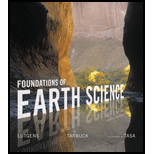
a)
The type of volcano and the features used in classification by observing the given photo.
a)
Answer to Problem 1GST
The volcano identified in the accompanying photo is composite cone or stratovolcano and is identified by its shape. It has steep summit and gently sloping flanks and appears taller than a cinder cone.
Explanation of Solution
Volcanoes are massive conical structures that act as vents for the magma to flow on to the surface. The volcanoes mostly occur near the plate boundaries or sometimes occur along the stationary hot spots.
The given type of volcano is a composite volcano or stratovolcano. The feature used in identifying it is its distinct shape even though the size is also consistent with a composite volcano. It has a symmetrical structure with a steep summit area and gently sloping flanks. It looks significantly taller than a cinder cone.
b)
The eruptive style, the composition, and viscosity of magma of the given volcano.
b)
Answer to Problem 1GST
This volcano has rhyolitic or andesitic composition with highly viscous magma and has an explosive eruptive style.
Explanation of Solution
Volcanoes are massive conical structures that act as vents for the magma to flow on to the surface. The volcanoes mostly occur near the plate boundaries or sometimes occur along the stationary hot spots.
This type of volcano is characterized by explosive eruptions with pyroclastic flows, ash, and lahars due to their thick and highly viscous magmas associated with them. They typically contain rhyolitic or andesitic composition.
c)
The type of plate boundary setting in the given volcano.
c)
Answer to Problem 1GST
The plate boundary setting for the given volcano is mainly found at the convergent plate boundaries.
Explanation of Solution
Volcanoes are massive conical structures that act as vents for the magma to flow on to the surface. The volcanoes mostly occur near the plate boundaries or sometimes occur along the stationary hot spots.
Composite volcanoes are formed at the subduction zones where the Earth’s plates collide and the denser plate slides beneath the other. Hence, they are found at the convergent plate boundaries.
d)
The city that is vulnerable to the effects of the given volcano type.
d)
Answer to Problem 1GST
The cities that are located mostly near the convergent plate boundaries, such as Fujiyoshida, gotemba, Fujinomiya in Japan; Tokyo, Japan; Seattle, Washington; Mexico City, Mexico; and Naples, Italy are vulnerable to this type of volcano.
Explanation of Solution
Volcanoes are massive conical structures that act as vents for the magma to flow on to the surface. The volcanoes mostly occur near the plate boundaries or sometimes occur along the stationary hot spots.
The volcano given in the question is a composite type of volcano. Composite volcanoes consist of symmetrical structure with a steep summit area and gently sloping flanks produced by andesitic magma with pyroclastic materials and lava flows. These are mostly seen at the convergent plate boundaries.
Mount Fuji is a stratovolcano that endangers the Fujiyoshida city to the north, Gotemba city to the south, and Fujinomiya city to the southwest. Tokyo may even be vulnerable as it is given that an extremely large volcanic eruption occurs.
Want to see more full solutions like this?
Chapter 7 Solutions
Foundations Of Earth Science Plus Mastering Geology With Pearson Etext -- Access Card Package (8th Edition)
 Applications and Investigations in Earth Science ...Earth ScienceISBN:9780134746241Author:Edward J. Tarbuck, Frederick K. Lutgens, Dennis G. TasaPublisher:PEARSON
Applications and Investigations in Earth Science ...Earth ScienceISBN:9780134746241Author:Edward J. Tarbuck, Frederick K. Lutgens, Dennis G. TasaPublisher:PEARSON Exercises for Weather & Climate (9th Edition)Earth ScienceISBN:9780134041360Author:Greg CarbonePublisher:PEARSON
Exercises for Weather & Climate (9th Edition)Earth ScienceISBN:9780134041360Author:Greg CarbonePublisher:PEARSON Environmental ScienceEarth ScienceISBN:9781260153125Author:William P Cunningham Prof., Mary Ann Cunningham ProfessorPublisher:McGraw-Hill Education
Environmental ScienceEarth ScienceISBN:9781260153125Author:William P Cunningham Prof., Mary Ann Cunningham ProfessorPublisher:McGraw-Hill Education Earth Science (15th Edition)Earth ScienceISBN:9780134543536Author:Edward J. Tarbuck, Frederick K. Lutgens, Dennis G. TasaPublisher:PEARSON
Earth Science (15th Edition)Earth ScienceISBN:9780134543536Author:Edward J. Tarbuck, Frederick K. Lutgens, Dennis G. TasaPublisher:PEARSON Environmental Science (MindTap Course List)Earth ScienceISBN:9781337569613Author:G. Tyler Miller, Scott SpoolmanPublisher:Cengage Learning
Environmental Science (MindTap Course List)Earth ScienceISBN:9781337569613Author:G. Tyler Miller, Scott SpoolmanPublisher:Cengage Learning Physical GeologyEarth ScienceISBN:9781259916823Author:Plummer, Charles C., CARLSON, Diane H., Hammersley, LisaPublisher:Mcgraw-hill Education,
Physical GeologyEarth ScienceISBN:9781259916823Author:Plummer, Charles C., CARLSON, Diane H., Hammersley, LisaPublisher:Mcgraw-hill Education,





